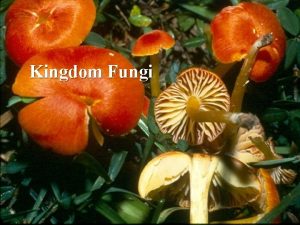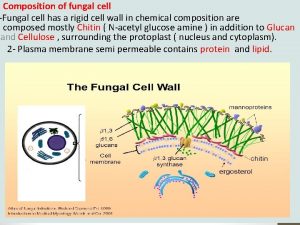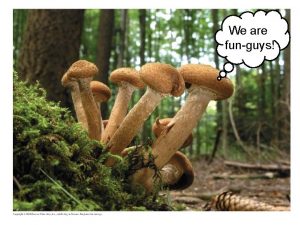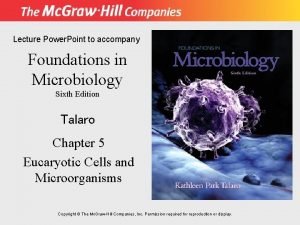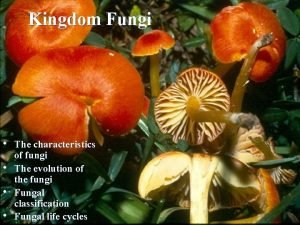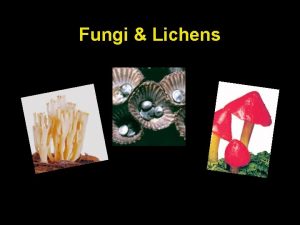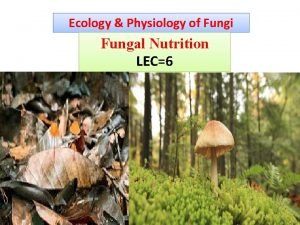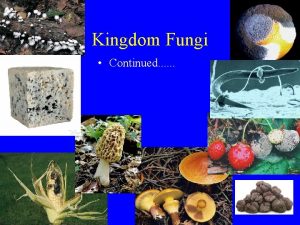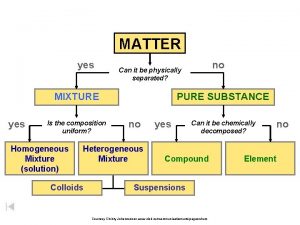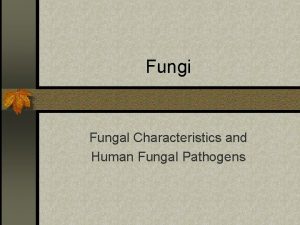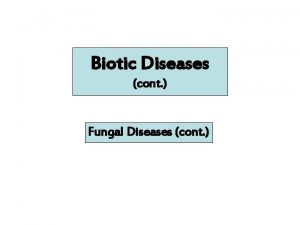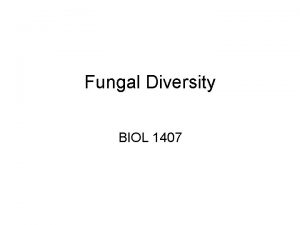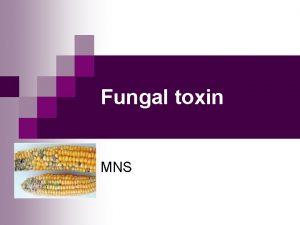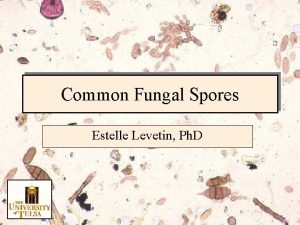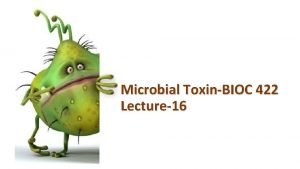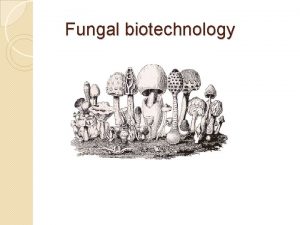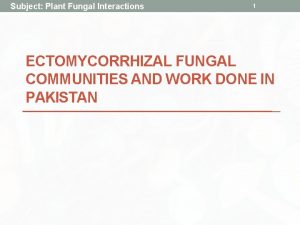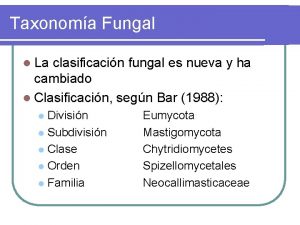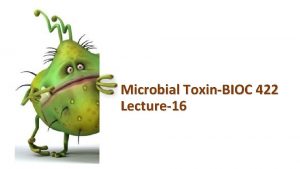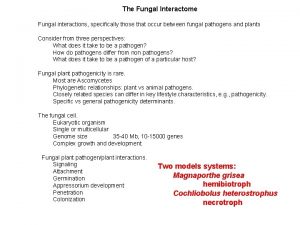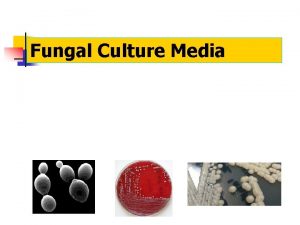Composition of fungal cell Fungal cell has a
































- Slides: 32

Composition of fungal cell -Fungal cell has a rigid cell wall in chemical composition are composed mostly Chitin ( N-acetyl glucose amine ) in addition to Glucan and Cellulose , surrounding the protoplast ( nucleus and cytoplasm). 2 - Plasma membrane semi permeable contains protein and lipid.

3 - Nucleus most fungi have very small nuclei, with little repetitive DNA. surrounding by nuclear membrane. 4 - Other organelles Mitochondria—flattened or plate-like mitochondrial cristae in Fungi (similar to animals) Golgi bodies— consist of a single, tubular cisternal element (stacked, plate-like cisternae in animals and plants) Other types: ribosomes, endoplasmic reticulum, vacuoles, lipid bodies, glycogen storage particles, microbodies, microtubules, vesicles

• Somatic phase of fungi • 1 -Yeasts are single-celled unicellular , ovaloid -all are facultative anaerobes. -in absence of oxygen will ferment carbohydrates into alcohol & carbon dioxide

• 2 -Multicellular fungi are composed of filaments called hyphae (singular: hypha). contain from Cylindrical, branching filaments composed of a tubular cell wall filled with cytoplasm and organelles. Hyphae are divided into two types according to exist of internal cross walls, called septa,

A-septate hyphae that divide the hyphae into separate cells B--A septated hyphae or Coenocytic hyphae lack septa.

• The septa of many species have pores, allowing cytoplasm to flow freely from one cell to the next. Cytoplasmic movement within the hypha provides a means to transport of materials. The hyphae may be branched. A mass of hyphae that is not a reproductive structure is called a mycelium

• Molds represent the basic structure of all fungi: a web like network of microscopic strands called mycelium (a hypha (plural hyphae) is a long, branching filamentous structure of a fungus ).

• Nutritional status of fungi • According to the type of nutrition fungi are classified into three types: • 1 -Saprophytic fungi : -feed on dead plant and animal remains. Many are extremely beneficial, breaking down this organic material into inorganic that can be utilised by plants. Without these fungi we would also disappear under a mountain of unrotten dead leaves and logs! • use non-living organic material. • important scavengers in ecosystems. • Along with bacteria, fungi are important in recycling Carbon, Nitrogen, and essential mineral nutrients.

• 2 -Parasitic fungi or pathogenic fungi, fungi that use as a source of food live tissues of various organisms. cause diseases in plants, animals, and humans. • use organic material from living organisms, harming them in some way. cause diseases in plants, animals, and humans.

• 3 -symbiotic fungi • fungi that have a symbiotically beneficial relationship with other living organisms. • Like : • -Mycorrhizae: associations of fungi with plants roots • Lichens associations of fungi with algae or cyanobacteria


• Fungi Reproduction • Fungi can reproduce either sexually or asexually. Reproductive structures of fungi that produce gametes are called gametangia, and those that produce asexual spores are Sporangia Fungal spores are non-motile and are typically very tiny and dry. Spores which explode from a sporangium may travel up to two meters from their origin, a huge distance considering their tiny size. Other spores are slimy and are dispersed by adhering to the bodies of arthropods, such as insects.

• A- Asexual reproduction (somatic or vegetative reproduction ) is very common in fungi and occurs by variety of mechanisms. • 1. Budding • The parent cell produces one or more projections called buds, which later develop necessary structures and separated to grow into new individuals. Budding is common in unicellular forms like yeast.

• 2 -Fission • In this process, the parent cell splits into two equal halves, each of which develop into a new individual. Fission is also common in yeast. • 3 - Fragmentation of hyphae (mold): • In this process, the mycelium breaks into two or more similar fragments either accidentally or due to some external force. Each fragment grows into a new mycelium.

• 4 - Asexual spores • -spores are produced by mitosis and cell division , formed on the ends of aerial hyphae (not endospores: reproductive) -germinate to form exact clones of the Parent. asexual spores are different in color , size and shape most of them are small

• or big , yellow , pink , unicellular or multicellular therefore fungi taxonomists are depended on asexual spore in classification of fungi. The fungal spores always result from mitosis and hence are described as mitospores. Following are the types of spores produced in different groups of fungi:

• 1 -Zoospores • They are flagellated, motile spores produced inside structures called zoosporangia. These spores do not have a cell wall. Such spores are produced in lower fungi such as water molds

• 2 -Sporagiospores • These are non-motile spores produced inside structures called sporangia in fungi such as Rhizopus (bread mold ). These spores are dispersed by wind.

• 3 -Conidia • These are non-motile asexual unit produced singly or in chains at the tip of the hypha branches that are called conidiophores. Such conidia are produced in fungi like Aspergillus and Penicillium.


B-Sexual Reproduction In fungi, as in other organisms, sexual reproduction greatly increases variability in a species. In fungi, sexual reproduction often occurs in response to adverse environmental conditions.

Sexual reproduction in fungi consists of three sequential stages: plasmogamy, karyogamy, and meiosis. 1 - Plasmogamy, the fusion of two protoplasts (the contents of the two cells), brings together two compatible haploid nuclei. 2 -Karyogamy, two nuclei types are present in the same cell, but the nuclei have not yet fused. Karyogamy results in the fusion of these haploid nuclei and the formation of a diploid nucleus (i. e. , a nucleus containing two sets of chromosomes, one from each parent). The cell formed by karyogamy is called the zygote. •

3 -Meiosis (cell division that reduces the chromosome number to one set per cell) generally follows and restores the haploid phase. The haploid nuclei that result from meiosis are generally incorporated in spores called meiospore

In most of the lower fungi plasmogamy is mmediately followed by karyogamy and meiosis. In higher fungi karyogamy is often delayed so that the hyphae remain dikaryotic. This phase of fungal life cycle is called dikaryophase. Such fungi complete their life cycle in three phases a haplophase, a dikaryophase and a diplophase. .

Following are the types of sexual reproduction in different groups of fungi: Planogametic Copulation • Here motile gametes called planogametes undergo fusion. When both the gametes are motile and morphologically similar, the fusion process is called isogamy. But Anisogamy two motile gametes are fused and morphologically different.

Gametangial Contact • Here, gamete bearing structures called gametangia (Antheridium male gametanium , Oogonium female gametangium ) come closer to each other and develop a fertilization tube through which the male gamete migrates into the female gametangium.

• Gametangial Copulation • Here, the gametangia fuse with each other, lose their identity and develop into a zygospore

• Spermatisation In some fungi like Puccinia, tiny unicellular spore like structures (1 n) called spermatia bearing on spermatophore and They get transferred to (receptive hypha) through various agencies (wind , insects , air , water etc ) , A pore develops at the point of contact between the hypha and the spermatium then the contents of spermatium(including its nucleus) pass into the hyphal compartment, which as a result becomes dikaryotic. .

• Somatogamy : this type occurs in higher fungi , The fusion of somatic hyphae of two compatible mycelia results in a dikaryon from which a dikaryotic mycelium may develop. the dikaryotic phase is limited to mycelium within the fruiting body.

• Life Cycle In general, fungi begin their lives as a spore, then germinate and develop into mycelium. in the life cycle of a sexually reproducing fungus, a haploid phase alternates with a diploid phase. The haploid phase ends with nuclear fusion, and the diploid phase begins with the formation of the zygote (the diploid cell resulting from fusion of two haploid sex cells). Meiosis (reduction division) and initiates the haploid phase, which produces the gametes. In the majority of fungi, all structures are haploid except the zygote. Nuclear fusion takes place at the time of zygote formation, and meiosis follows immediately.

• Fungi usually reproduce both sexually and asexually. The asexual cycle produces mitospores, and the sexual cycle produces meiospores. Even though both types of spores are produced by the same mycelium, they are very different in form and easily distinguished. The asexual phase usually precedes the sexual phase in the life cycle and may be repeated frequently before the sexual phase appears

 Kingdom fungi cell wall
Kingdom fungi cell wall Single celled fungi
Single celled fungi Xenosporas
Xenosporas What conditions do fungal organisms favor for growth
What conditions do fungal organisms favor for growth Ocular histoplasmosis
Ocular histoplasmosis Allergic fungal sinusitis treatment
Allergic fungal sinusitis treatment Milady chapter 10 nail disorders and diseases
Milady chapter 10 nail disorders and diseases There fungus among us
There fungus among us Csf analysis interpretation
Csf analysis interpretation Fungal reproduction
Fungal reproduction Chytridiomycota examples
Chytridiomycota examples Classification of fungi
Classification of fungi Haustorium in fungi
Haustorium in fungi Allergic fungal sinusitis treatment
Allergic fungal sinusitis treatment Phyla
Phyla Copper does it have a uniform composition
Copper does it have a uniform composition Bacterial structure
Bacterial structure Density of golden syrup g/cm3
Density of golden syrup g/cm3 The problem has been detected and windows shutdown
The problem has been detected and windows shutdown Stop detected initiating rtx shutdown
Stop detected initiating rtx shutdown The spring has sprung poem
The spring has sprung poem Every picture has a story and every story has a moment
Every picture has a story and every story has a moment Mark 4:23-24
Mark 4:23-24 Composite cell diagram
Composite cell diagram Centrolecithal
Centrolecithal Volvox diagram
Volvox diagram Advantages and disadvantages of diaphragm cell process
Advantages and disadvantages of diaphragm cell process Prokaryotic cell vs eukaryotic cell
Prokaryotic cell vs eukaryotic cell Prokaryotic cell and eukaryotic cell similarities
Prokaryotic cell and eukaryotic cell similarities Animal cell and plant cell venn diagram
Animal cell and plant cell venn diagram Lithium ion battery reaction equation
Lithium ion battery reaction equation Dry cell vs wet cell
Dry cell vs wet cell Plant cell vs animal cell venn diagram
Plant cell vs animal cell venn diagram
